Course
Data analysis is a comprehensive method of inspecting, cleansing, transforming, and modeling data to discover useful information, draw conclusions, and support decision-making. It is a multifaceted process involving various techniques and methodologies to interpret data from various sources in different formats, both structured and unstructured.
In this article, we will give you a good look at the data analysis. If, at the end, you want to explore the field, follow up with our companion article called, How to Become a Data Analyst, which covers everything you need to know about launching your career and the skills you’ll need to master.
What is Data Analysis?
Data analysis is not just a mere process; it's a tool that empowers organizations to make informed decisions, predict trends, and improve operational efficiency. It's the backbone of strategic planning in businesses, governments, and other organizations.
Consider some examples. Take, for instance, a leading e-commerce company. Through data analysis, the company can understand their customers' buying behavior, preferences, and patterns. They can then use this information to personalize customer experiences, forecast sales, and optimize marketing strategies, ultimately driving business growth and customer satisfaction.
Another good example is the healthcare industry. Through data analysis, healthcare providers can predict disease outbreaks, improve patient care, and make informed decisions about treatment strategies. Similarly, in the finance sector, data analysis can help in risk assessment, fraud detection, and investment decision-making. Finally, we've also seen the impact of AI in healthcare, demonstrating the rapidly changing environment and the need for ongoing analysis.
AI Upskilling for Beginners
The Importance of Data Analysis in 2024
In the era of digital transformation, data analysis has become more critical than ever. The explosion of data generated by digital technologies has led to the advent of what we now call 'big data.' This vast amount of data, if analyzed correctly, can provide invaluable insights that can revolutionize businesses. Statista estimates that 'the market size for business intelligence and analytics software applications is forecast to increase worldwide over the next few years from 15.3 billion U.S. dollars in 2021 to more than 18 billion in 2026'.
Data analysis is the key to unlocking the potential of big data. It helps organizations to make sense of this data, turning it into actionable insights. These insights can be used to improve products and services, enhance experiences, streamline operations, and increase profitability.
The Data Analysis Process: A Step-by-Step Guide
The process of data analysis is a systematic approach that involves several stages. Here, we'll walk you through each step, from defining objectives to data storytelling. You can learn more about how businesses analyze data in a separate guide.
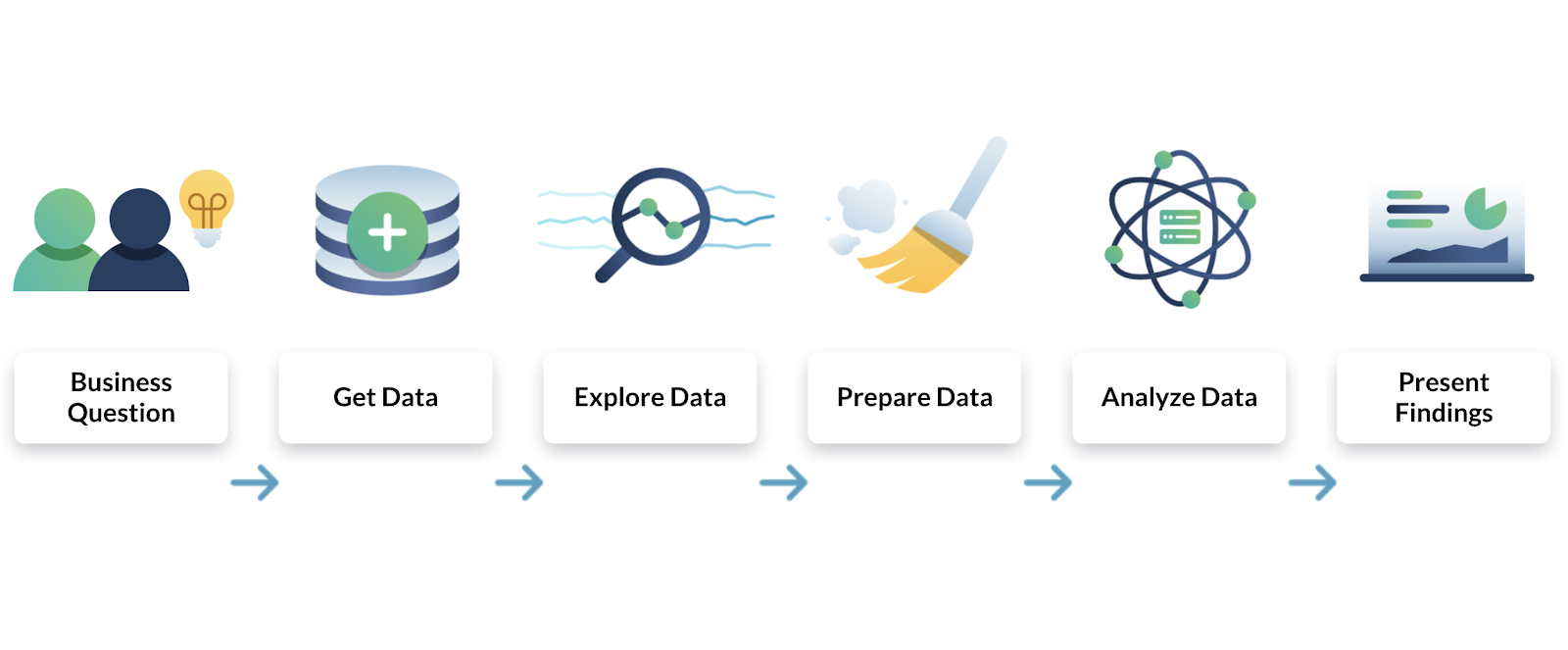
The data analysis process in a nutshell
Step 1: Defining objectives and questions
The first step in the data analysis process is to define the objectives and formulate clear, specific questions that your analysis aims to answer. This step is crucial as it sets the direction for the entire process. It involves understanding the problem or situation at hand, identifying the data needed to address it, and defining the metrics or indicators to measure the outcomes.
Step 2: Data collection
Once the objectives and questions are defined, the next step is to collect the relevant data. This can be done through various methods such as surveys, interviews, observations, or extracting from existing databases. The data collected can be quantitative (numerical) or qualitative (non-numerical), depending on the nature of the problem and the questions being asked.
Step 3: Data cleaning
Data cleaning, also known as data cleansing, is a critical step in the data analysis process. It involves checking the data for errors and inconsistencies, and correcting or removing them. This step ensures the quality and reliability of the data, which is crucial for obtaining accurate and meaningful results from the analysis.
Step 4: Data analysis
Once the data is cleaned, it's time for the actual analysis. This involves applying statistical or mathematical techniques to the data to discover patterns, relationships, or trends. There are various tools and software available for this purpose, such as Python, R, Excel, and specialized software like SPSS and SAS.
Step 5: Data interpretation and visualization
After the data is analyzed, the next step is to interpret the results and visualize them in a way that is easy to understand. This could involve creating charts, graphs, or other visual representations of the data. Data visualization helps to make complex data more understandable and provides a clear picture of the findings.
Step 6: Data storytelling
The final step in the data analysis process is data storytelling. This involves presenting the findings of the analysis in a narrative form that is engaging and easy to understand. Data storytelling is crucial for communicating the results to non-technical audiences and for making data-driven decisions.
The Types of Data Analysis
Data analysis can be categorized into four main types, each serving a unique purpose and providing different insights. These are descriptive, diagnostic, predictive, and prescriptive analyses.
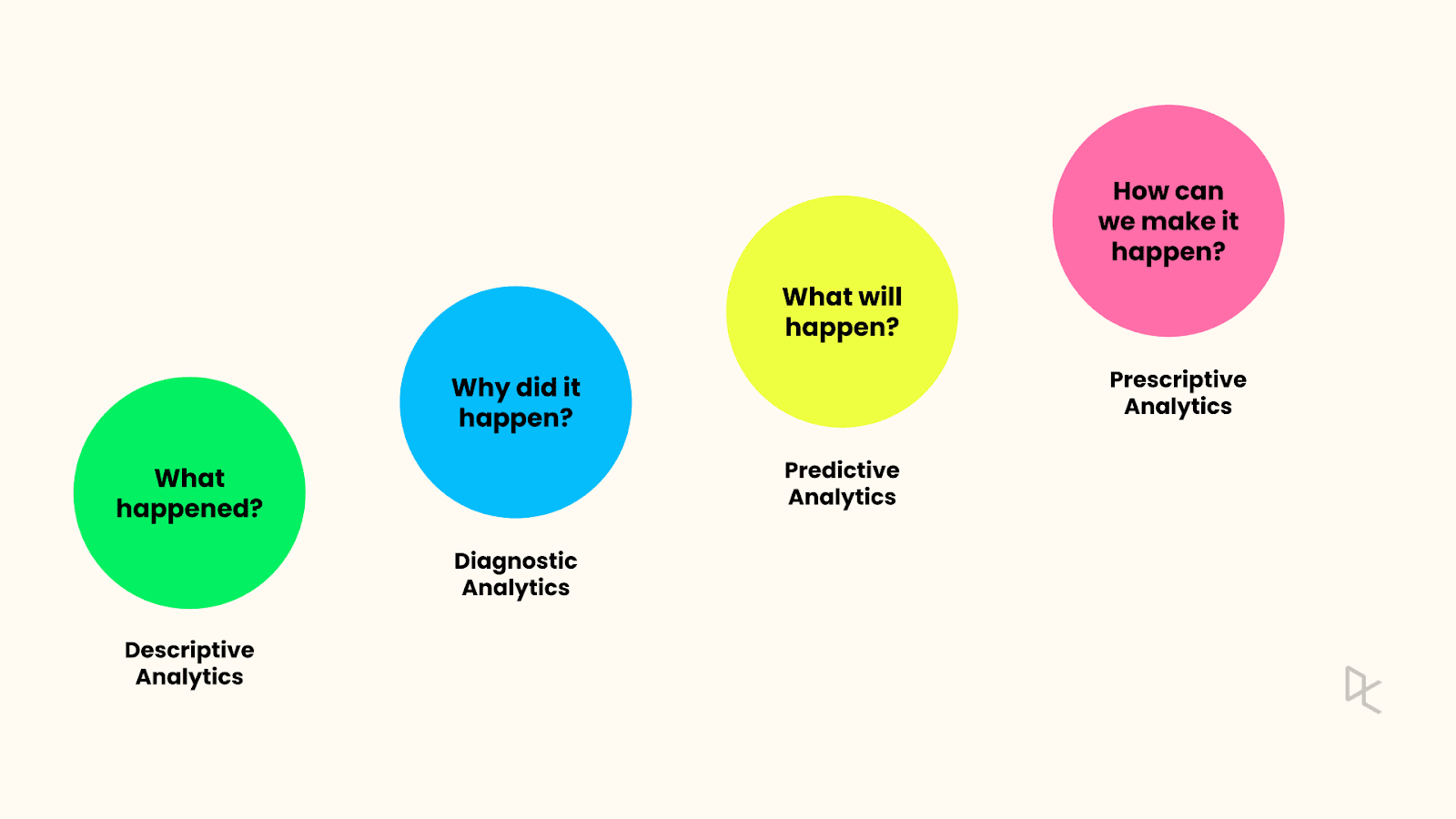
Descriptive analysis
Descriptive analysis, as the name suggests, describes or summarizes raw data and makes it interpretable. It involves analyzing historical data to understand what has happened in the past. This type of analysis is used to identify patterns and trends over time.
For example, a business might use descriptive analysis to understand the average monthly sales for the past year.
Diagnostic analysis
Diagnostic analysis goes a step further than descriptive analysis by determining why something happened. It involves more detailed data exploration and comparing different data sets to understand the cause of a particular outcome.
For instance, if a company's sales dropped in a particular month, diagnostic analysis could be used to find out why.
Predictive analysis
Predictive analysis uses statistical models and forecasting techniques to understand the future. It involves using data from the past to predict what could happen in the future. This type of analysis is often used in risk assessment, marketing, and sales forecasting.
For example, a company might use predictive analysis to forecast the next quarter's sales based on historical data.
Prescriptive analysis
Prescriptive analysis is the most advanced type of data analysis. It not only predicts future outcomes but also suggests actions to benefit from these predictions. It uses sophisticated tools and technologies like machine learning and artificial intelligence to recommend decisions.
For example, a prescriptive analysis might suggest the best marketing strategies to increase future sales.
Data Analysis Techniques
There are numerous techniques used in data analysis, each with its unique purpose and application. Here, we will discuss some of the most commonly used techniques, including exploratory analysis, regression analysis, factor analysis, and others.
Exploratory analysis
Exploratory analysis is used to understand the main characteristics of a data set. It is often used at the beginning of a data analysis process to summarize the main aspects of the data, check for missing data, and test assumptions. This technique involves visual methods such as scatter plots, histograms, and box plots.
You can learn more about exploratory data analysis with our course, covering how to explore, visualize, and extract insights from data using Python.
Regression analysis
Regression analysis is a statistical method used to understand the relationship between a dependent variable and one or more independent variables. It is commonly used for forecasting, time series modeling, and finding the causal effect relationships between variables.
We have some helpful tutorials, such as simple linear regression, as well as technology-specific ones: Essentials of Linear Regression in Python and How to Do Linear Regression in R. Linear regression is worth knowing in detail because it is one of the most widely used techniques for understanding relationships and making predictions.

Linear and logistic regression
Factor analysis
Factor analysis is a technique used to reduce a large number of variables into fewer factors. The factors are constructed in such a way that they capture the maximum possible information from the original variables. This technique is often used in market research, customer segmentation, and image recognition.
Learn more about factor analysis in R with our course, which explores latent variables, such as personality, using exploratory and confirmatory factor analyses.
Monte Carlo simulation
Monte Carlo simulation is a technique that uses probability distributions and random sampling to estimate numerical results. It is often used in risk analysis and decision-making where there is significant uncertainty.
We have a tutorial that explores Monte Carlo methods in R, as well as a course on Monte Carlo simulations in Python, which can estimate a range of outcomes for uncertain events.
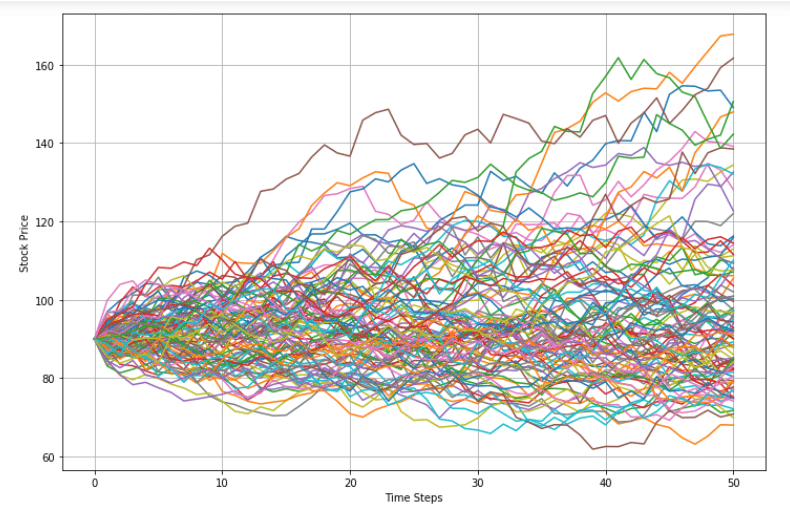
Example of a Monte Carlo simulation
Cluster analysis
Cluster analysis is a technique used to group a set of objects in such a way that objects in the same group (called a cluster) are more similar to each other than to those in other groups. It is often used in market segmentation, image segmentation, and recommendation systems.
You can explore a range of clustering techniques, including hierarchical clustering and k-means clustering, in our Cluster Analysis in R course.
Cohort analysis
Cohort analysis is a subset of behavioral analytics that takes data from a given dataset and groups it into related groups for analysis. These related groups, or cohorts, usually share common characteristics within a defined time span. This technique is often used in marketing, user engagement, and customer lifecycle analysis.
Our course, Customer Segmentation in Python, explores a range of techniques for segmenting and analyzing customer data, including cohort analysis.
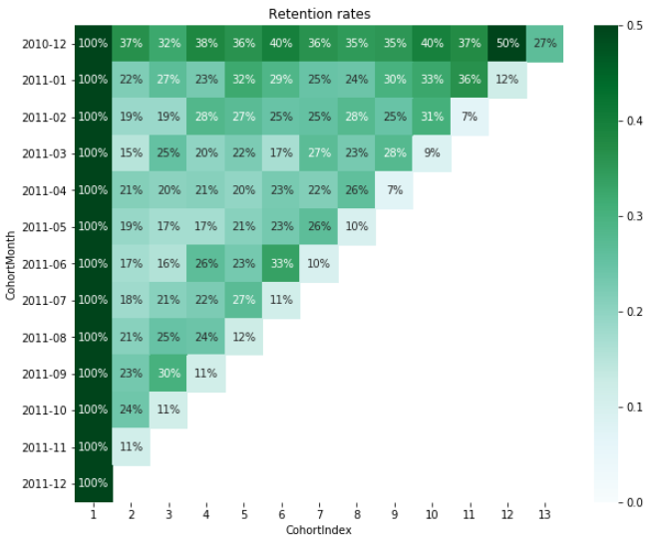
Graph showing an example of cohort analysis
Time series analysis
Time series analysis is a statistical technique that deals with time series data, or trend analysis. It is used to analyze the sequence of data points to extract meaningful statistics and other characteristics of the data. This technique is often used in sales forecasting, economic forecasting, and weather forecasting.
Our Time Series with Python skill track and Forecasting in R course takes you through how to manipulate and analyze time series data, working with a variety of different libraries.
Sentiment analysis
Sentiment analysis, also known as opinion mining, uses natural language processing, text analysis, and computational linguistics to identify and extract subjective information from source materials. It is often used in social media monitoring, brand monitoring, and understanding customer feedback.
To get familiar with sentiment analysis in Python, you can take our online course, which will teach you how to perform an end-to-end sentiment analysis.
Data Analysis Tools
In the realm of data analysis, various tools are available that cater to different needs, complexities, and levels of expertise. These tools range from programming languages like Python and R to visualization software like Power BI and Tableau. Let's delve into some of these tools.
Python
Python is a high-level, general-purpose programming language that has become a favorite among data analysts and data scientists. Its simplicity and readability, coupled with a wide range of libraries like pandas, NumPy, and Matplotlib, make it an excellent tool for data analysis and data visualization.
Resources to get you started
- You can start learning Python today with our Python Fundamentals skill track, which covers all the foundational skills you need to understand the language.
- You can also take out Data Analyst with Python career track to start your journey to becoming a data analyst.
- Check out our Python for beginners cheat sheet as a handy reference guide.
R
R is a programming language and free software environment specifically designed for statistical computing and graphics. It is widely used among statisticians and data miners for developing statistical software and data analysis. R provides a wide variety of statistical and graphical techniques, including linear and nonlinear modeling, classical statistical tests, time-series analysis, and more.
Resources to get you started
- Our R Programming skill track will introduce you to R and help you develop the skills you’ll need to start coding in R.
- With the Data Analyst with R career track, you’ll gain the skills you need to start your journey to becoming a data analyst.
- Our Getting Started with R cheat sheet helps give an overview of how to start learning R Programming.
SQL
SQL (Structured Query Language) is a standard language for managing and manipulating databases. It is used to retrieve and manipulate data stored in relational databases. SQL is essential for tasks that involve data management or manipulation within databases.
Resources to get you started
- To get familiar with SQL, consider taking our SQL Fundamentals skill track, where you’ll learn how to interact with and query your data.
- SQL for Business Analysts will boost your business SQL skills.
- Our SQL Basics cheat sheet covers a list of functions for querying data, filtering data, aggregation, and more.
Power BI
Power BI is a business analytics tool developed by Microsoft. It provides interactive visualizations with self-service business intelligence capabilities. Power BI is used to transform raw data into meaningful insights through easy-to-understand dashboards and reports.
Resources to get you started
- Explore the power of Power BI with our Power BI Fundamentals skill track, where you’ll learn to get the most from the business intelligence tool.
- With Exploratory Data Analysis in Power BI you’ll learn how to enhance your reports with EDA.
- We have a Power BI cheat sheet which covers many of the basics you’ll need to get started.
Tableau
Tableau is a powerful data visualization tool used in the Business Intelligence industry. It allows you to create interactive and shareable dashboards, which depict trends, variations, and density of the data in the form of charts and graphs.
Resources to get you started
- The Tableau Fundamentals skill track will introduce you to the business intelligence tool and how you can use it to clear, analyze, and visualize data.
- Analyzing Data in Tableau will give you some of the advanced skills needed to improve your analytics and visualizations.
- Check out our Tableau cheat sheet, which runs you through the essentials of how to get started using the tool.
Excel
Microsoft Excel is one of the most widely used tools for data analysis. It offers a range of features for data manipulation, statistical analysis, and visualization. Excel's simplicity and versatility make it a great tool for both simple and complex data analysis tasks.
Resources to get you started
- Check out our Data Analysis in Excel course to build functional skills in Excel.
- For spreadsheet skills in general, check out Marketing Analytics in Spreadsheets.
- The Excel Basics cheat sheet covers many of the basic formulas and operations you’ll need to make a start.
Understanding the Impact of Data Analysis
Data analysis, whether on a small or large scale, can have a profound impact on business performance. It can drive significant changes, leading to improved efficiency, increased profitability, and a deeper understanding of market trends and customer behavior.
Informed decision-making
Data analysis allows businesses to make informed decisions based on facts, figures, and trends, rather than relying on guesswork or intuition. It provides a solid foundation for strategic planning and policy-making, ensuring that resources are allocated effectively and that efforts are directed towards areas that will yield the most benefit.
Impact on small businesses
For small businesses, even simple data analysis can lead to significant improvements. For example, analyzing sales data can help identify which products are performing well and which are not. This information can then be used to adjust marketing strategies, pricing, and inventory management, leading to increased sales and profitability.
Impact on large businesses
For larger businesses, the impact of data analysis can be even more profound. Big data analysis can uncover complex patterns and trends that would be impossible to detect otherwise. This can lead to breakthrough insights, driving innovation and giving the business a competitive edge.
For example, a large retailer might use data analysis to optimize its supply chain, reducing costs and improving efficiency. Or a tech company might use data analysis to understand user behavior, leading to improved product design and better user engagement.
The critical role of data analysis
In today's data-driven world, the ability to analyze and interpret data is a critical skill. Businesses that can harness the power of data analysis are better positioned to adapt to changing market conditions, meet customer needs, and drive growth and profitability.
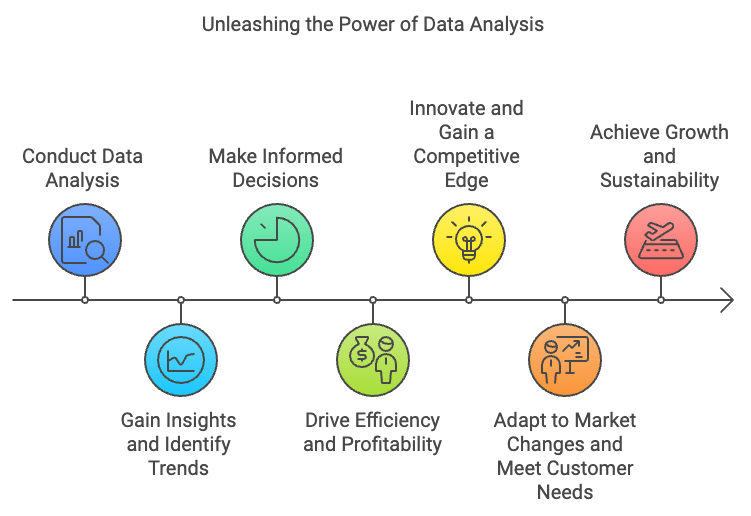
Created using Napkin.AI
Get started with DataCamp for Business
Build a data-driven workforce with DataCamp for business
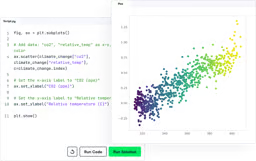
Top Careers in Data Analysis in 2024
In the era of big data, careers in data analysis are flourishing. With the increasing demand for insights, these professions offer promising prospects. Here, we will discuss some of the top careers in data analysis in 2024, referring to our full guide on the top ten analytics careers. Notice how data analysis skills are needed for jobs beyond the ones that have "Data Analyst" as the title.
1. Data scientist
Data scientists are the detectives of the data world, uncovering patterns, insights, and trends from vast amounts of information. They use a combination of programming, statistical skills, and machine learning to make sense of complex data sets. Data scientists not only analyze data but also use their insights to influence strategic decisions within their organization.
We’ve got a complete guide on how to become a data scientist, which outlines everything you need to know about starting your career in the industry.
2. Business intelligence analyst
Business intelligence analysts are responsible for providing a clear picture of a business's performance by analyzing data related to market trends, business processes, and industry competition. They use tools and software to convert complex data into digestible reports and dashboards, helping decision-makers to understand the business's position and make informed decisions.
3. Data engineer
Data engineers are the builders and maintainers of the data pipeline. They design, construct, install, test, and maintain highly scalable data management systems. They also ensure that data is clean, reliable, and preprocessed for data scientists to perform analysis.
Read more about what a data engineer does and how you can become a data engineer in our separate guide.
4. Business analyst
Business analysts are the bridge between IT and business stakeholders. They use data to assess processes, determine requirements, and deliver data-driven recommendations and reports to executives and stakeholders. They are involved in strategic planning, business model analysis, process design, and system analysis.
| Career | Key Skills | Essential Tools |
|---|---|---|
| Data Scientist | Proficiency in programming, strong statistical knowledge, familiarity with machine learning, data wrangling skills, and effective communication. | Python, R, SQL, Scikit-learn, TensorFlow, Matplotlib, Seaborn |
| Business Intelligence Analyst | Strong analytical skills, proficiency in SQL, understanding of data warehousing and ETL, ability to create visualizations and reports, and business acumen. | SQL, Power BI, Tableau, Excel, Python |
| Data Engineer | Proficiency in SQL and NoSQL, knowledge of distributed systems and data architecture, familiarity with ETL, programming skills, and understanding of machine learning. | SQL, NoSQL, Hadoop, Spark, Python, Java, ETL tools |
| Business Analyst | Strong analytical skills, understanding of business processes, proficiency in SQL, effective communication, and project management skills. | SQL, Excel, Power BI, Tableau, Python |
A table outlining different data analysis careers
How to Get Started with Data Analysis
Embarking on your journey into data analysis might seem daunting at first, but with the right resources and guidance, you can develop the necessary skills and knowledge. Here are some steps to help you get started, focusing on the resources available at DataCamp.
To thrive in data analysis, you must build a strong foundation of knowledge, sharpen practical skills, and accumulate valuable experience. Start with statistics, mathematics, and programming and tackle real-world projects. Then, gain domain expertise, and connect with professionals in the field. Combine expertise, skills, and experience for a successful data analysis career.
Richie Cotton, Data Evangelist at DataCamp
Understand the basics
Before diving into data analysis, it's important to understand the basics. This includes familiarizing yourself with statistical concepts, data types, and data structures. DataCamp's Introduction to Data Science in Python or Introduction to Data Science in R courses are great starting points.
Learn a programming language
Data analysis requires proficiency in at least one programming language. Python and R are among the most popular choices due to their versatility and the vast array of libraries they offer for data analysis. We offer comprehensive learning paths for both Python and R.
Master data manipulation and visualization
Data manipulation and visualization are key components of data analysis. They allow you to clean, transform, and visualize your data, making it easier to understand and analyze. Courses like Data Manipulation with pandas or Data Visualization with ggplot2 can help you develop these skills.
Dive into specific data analysis techniques
Once you've mastered the basics, you can delve into specific data analysis techniques like regression analysis, time series analysis, or machine learning. We offer a wide range of courses across many topics, allowing you to specialize based on your interests and career goals.
Practice, Practice, Practice
The key to mastering data analysis is practice. DataCamp's practice mode and projects provide hands-on experience with real-world data, helping you consolidate your learning and apply your skills. You can find a list of 20 data analytics projects for all levels to give you some inspiration.
Remember, learning data analysis is a journey. It's okay to start small and gradually build up your skills over time. With patience, persistence, and the right resources, you'll be well on your way to becoming a proficient data analyst.
Become a ML Scientist
Final Thoughts
Whether you're a marketer looking to understand customer behavior, a healthcare professional aiming to improve patient outcomes, or a business leader seeking to drive growth and profitability, data analysis can provide the insights you need to succeed.
Remember, data analysis is not just about numbers and statistics. It's about asking the right questions, being curious about patterns and trends, and having the courage to make data-driven decisions. It's about telling a story with data, a story that can influence strategies, change perspectives, and drive innovation.
So, we encourage you to apply your understanding of data analysis in your respective fields. Harness the power of data to uncover insights, make informed decisions, and drive success. The world of data is at your fingertips, waiting to be explored. Get started today with our Data Analyst with Python career track, which will give you the data analysis skills to manipulate, analyze, and visualize data.
FAQs
What is data analysis?
Data analysis is a comprehensive method that involves inspecting, cleansing, transforming, and modeling data to discover useful information, make conclusions, and support decision-making. It's a process that empowers organizations to make informed decisions, predict trends, and improve operational efficiency.
What are the steps in the data analysis process?
The data analysis process involves several steps, including defining objectives and questions, data collection, data cleaning, data analysis, data interpretation and visualization, and data storytelling. Each step is crucial to ensuring the accuracy and usefulness of the results.
What are the different types of data analysis?
Data analysis can be categorized into four types: descriptive, diagnostic, predictive, and prescriptive analysis. Descriptive analysis summarizes raw data, diagnostic analysis determines why something happened, predictive analysis uses past data to predict the future, and prescriptive analysis suggests actions based on predictions.
What are some commonly used data analysis techniques?
There are various data analysis techniques, including exploratory analysis, regression analysis, Monte Carlo simulation, factor analysis, cohort analysis, cluster analysis, time series analysis, and sentiment analysis. Each has its unique purpose and application in interpreting data.
What are some of the tools used in data analysis?
Data analysis typically utilizes tools such as Python, R, SQL for programming, and Power BI, Tableau, and Excel for visualization and data management.
How can I start learning data analysis?
You can start learning data analysis by understanding the basics of statistical concepts, data types, and structures. Then learn a programming language like Python or R, master data manipulation and visualization, and delve into specific data analysis techniques.
How can I become a data analyst?
Becoming a Data Analyst requires a strong understanding of statistical techniques and data analysis tools. Mastery of software such as Python, R, Excel, and specialized software like SPSS and SAS is typically necessary. Read our full guide on how to become a Data Analyst and consider our Data Analyst Certification to get noticed by recruiters.

A senior editor in the AI and edtech space. Committed to exploring data and AI trends.

Adel is a Data Science educator, speaker, and VP of Media at DataCamp. Adel has released various courses and live training on data analysis, machine learning, and data engineering. He is passionate about spreading data skills and data literacy throughout organizations and the intersection of technology and society. He has an MSc in Data Science and Business Analytics. In his free time, you can find him hanging out with his cat Louis.


